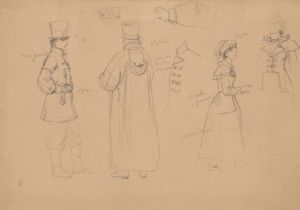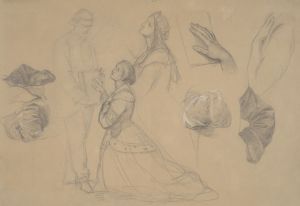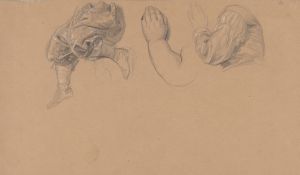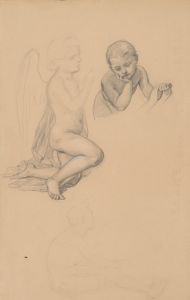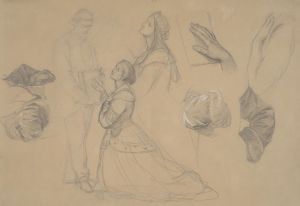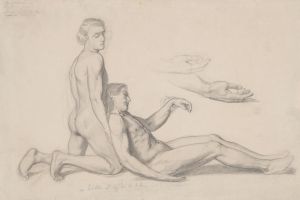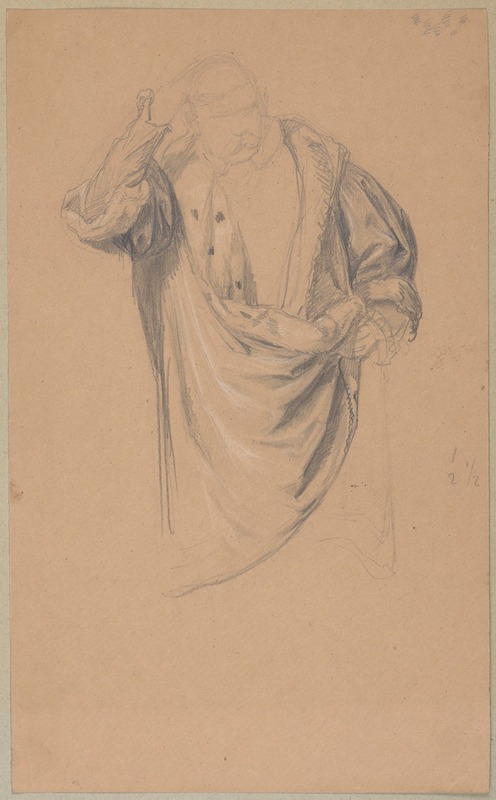
Studium do postaci księcia Jana Finlandzkiego do obrazu ‘Katarzyna Jagiellonka w więzieniu w Gripsholmie’
A hand-painted replica of Józef Simmler’s masterpiece Studium do postaci księcia Jana Finlandzkiego do obrazu ‘Katarzyna Jagiellonka w więzieniu w Gripsholmie’, meticulously crafted by professional artists to capture the true essence of the original. Each piece is created with museum-quality canvas and rare mineral pigments, carefully painted by experienced artists with delicate brushstrokes and rich, layered colors to perfectly recreate the texture of the original artwork. Unlike machine-printed reproductions, this hand-painted version brings the painting to life, infused with the artist’s emotions and skill in every stroke. Whether for personal collection or home decoration, it instantly elevates the artistic atmosphere of any space.
Józef Simmler was a renowned Polish painter of the 19th century, known for his historical and portrait paintings. One of his notable works is "Katarzyna Jagiellonka w więzieniu w Gripsholmie" (Catherine Jagiellon in Prison at Gripsholm), which captures a poignant moment in Polish and Swedish history. The painting depicts Catherine Jagiellon, a Polish princess and later Queen of Sweden, during her imprisonment at Gripsholm Castle.
Catherine Jagiellon was born in 1526, the daughter of Sigismund I the Old, King of Poland, and Bona Sforza, an Italian duchess. In 1562, she married John, Duke of Finland, who was the son of Gustav I of Sweden. This marriage was part of the complex political alliances of the time, as the Jagiellonian dynasty sought to strengthen its influence in Northern Europe.
The couple's life took a dramatic turn when John rebelled against his half-brother, King Eric XIV of Sweden. As a result of this rebellion, John and Catherine were captured and imprisoned in Gripsholm Castle from 1563 to 1567. During their imprisonment, Catherine gave birth to their first child, a son named Sigismund, who would later become King of Poland and Sweden.
Simmler's painting captures the emotional depth of Catherine's experience during this period of captivity. The artwork is noted for its attention to detail and the ability to convey the somber mood of the scene. Catherine is depicted with a sense of dignity and resilience, despite the challenging circumstances she faced. The painting reflects Simmler's skill in rendering historical subjects with empathy and precision.
The historical context of the painting is significant, as it represents a period of political turmoil and personal hardship. Catherine's imprisonment was a direct result of the power struggles within the Swedish royal family and the broader geopolitical tensions of the time. Her eventual release came after Eric XIV was deposed, and John ascended to the Swedish throne as John III.
Józef Simmler, born in 1823 in Warsaw, was a prominent figure in Polish art. He studied in Dresden, Munich, and Paris, where he honed his skills in historical painting. Simmler was known for his meticulous approach to historical accuracy and his ability to capture the emotional essence of his subjects. His works often depicted significant events and figures from Polish history, contributing to the national identity and cultural heritage of Poland.
"Katarzyna Jagiellonka w więzieniu w Gripsholmie" is a testament to Simmler's artistic talent and his dedication to portraying historical narratives. The painting remains an important piece of Polish art, reflecting the complex interplay of history, politics, and personal stories. Through his work, Simmler has provided a window into the past, allowing viewers to connect with the experiences of historical figures like Catherine Jagiellon.
In summary, Józef Simmler's painting of Catherine Jagiellon in Gripsholm Castle is a significant work that captures a moment of historical and personal significance. It reflects the artist's skill in portraying historical subjects with depth and empathy, contributing to the rich tapestry of Polish cultural history.









